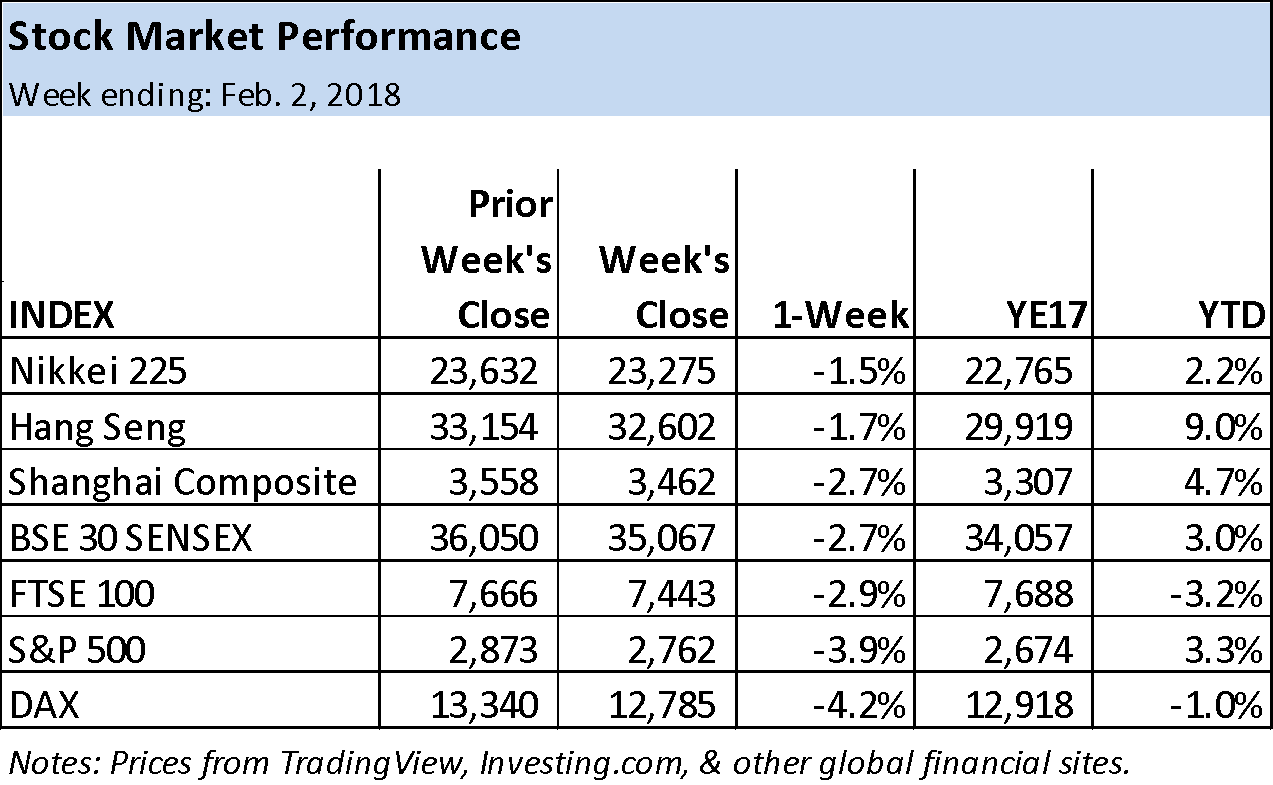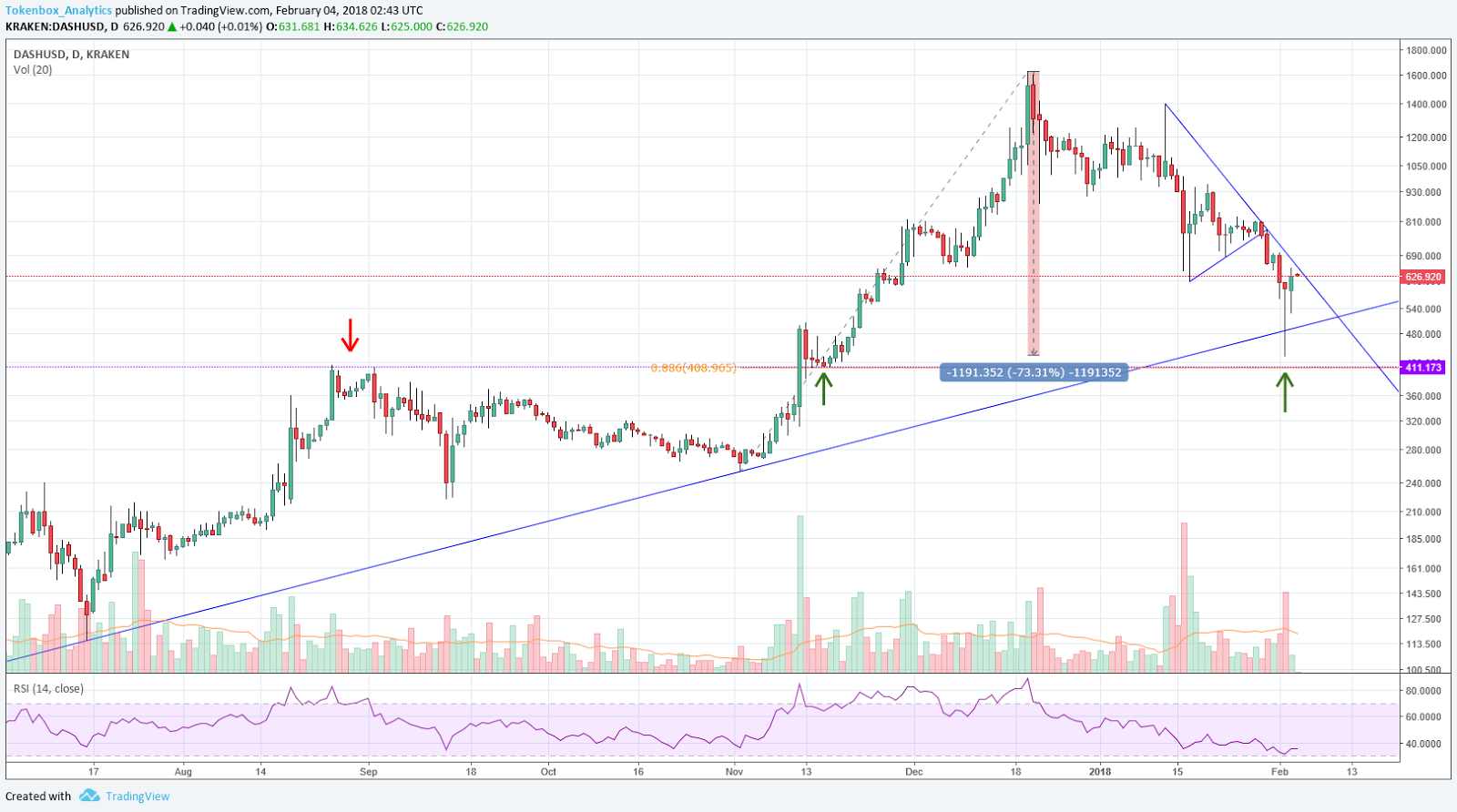
[ad_1]
The views and opinions expressed here are solely those of authors/contributors and do not necessarily reflect the views of Cointelegraph.com. Every investment and trading move involves risk, you should conduct your own research when making a decision.
The cryptocurrency market data is provided by the HitBTC exchange.
Equity markets sell-off
Global equity markets were hammered last week across the board as inflation fears and concern over higher interest rates intensified with bond yield rise. Each of the seven indices tracked below was down for the week (January 29 – February 4).
In the U.S., the S&P 500 Index fell by 3.9% for the week to close at 2,762. That’s the largest one-week decline in two years. Nevertheless, given its strong start to the New Year, the S&P remains up by 3.3% year-to-date. The Index just finished a 5.6% advance in January, its highest start to the year since 1997.
Harder hit was the German market, with the DAX down 4.2% for the week to close at 12,785, its worse week in almost two years. Bearish sentiment was partly driven by higher yields on German bunds, which rose to two-year highs, while Deutsche Bank losses were reported to be higher than anticipated by the market.
Japan’s Nikkei was the strongest performer, down 1.5% to end at 23,632. The Bank of Japan intervened in the market to halt rising bond yields. Japan was followed by Hong Kong’s Hang Seng Index, which dropped by 1.7% to end at 32,602. The Hang Seng remains a top performance year-to-date for a 9.0% gain.

BSE 30 Sensex: Clear bearish signal
Bearish behavior last week points to further downside for the BSE 30 Sensex. It completed an almost perfect ABCD pattern at the 161.8% Fibonacci extension of the first leg up off the February 2016 low (A to B). A bearish engulfing pattern occurred on the weekly chart as last week’s open was above the prior week’s close, and the close was below the prior week’s low. Last week’s high of 36,443.98 exceeded the prior week’s high of 36,268.19 by only a little before selling pressure took over to push the Index down below the prior week’s low, with the week ending near 35,006.41. The Sensex closed down 2.7% for the week at 35,066.75.
The first potential support zone is around the top of a six-week consolidation range around 33,865, followed by a lower previous support and resistance zone from approximately 32,686 to 32,565.

Hang Seng Index: Time for a rest
The Hang Seng Index has had a nice run recently, rising as much as 19% off the early-December low in eight weeks, as of last week’s 33,484.1 high. Last week the index was down for the first time during the eight-week run, falling 1.7% to close at 2,601.8, and pointing to a likely change in the pattern of consecutive up weeks.

In the bigger picture, the Hang Seng is going strong, having broken out above the 2007 high of 31,958.4 three weeks ago. At the same time, it broke out of the top of a multi-month rising trend channel. Each is a sign of strength. Nevertheless, in the near-term, it looks like it’s heading for a rest, even if it doesn’t last long. First, is the change in the pattern of consecutive positive weeks of performance, and then there is the 14-week Relative Strength Index (RSI). This momentum indicator was the most overbought since the prior record top in 2007, reaching a high of 82.75 two weeks ago. Further, just shy of the recent top is the confluence of two harmonic ratios, derived from prior swings.
Cryptocurrencies: Down across the board
Cryptocurrencies had a tough week, as most have since the start of the year. Out of 211 cryptocurrencies, only four were positive for the week, while the eight cryptos tracked below declined from a little over 10% to more than 26%.
Bearish sentiment was driven by a number of factors including:
- Worries about tighter regulation.
- India announcement on plans for much tighter restrictions.
- Major banks such as Citigroup, JPMorgan and Bank of America banned purchase of cryptocurrencies with their credit cards.
- Facebook ban of cryptocurrency and ICO ads.
- Premium for Bitcoin in South Korea drops.
- Japanese authorities perform an onsite inspection at Coincheck subsequent a robbery of almost $500 million of NEM coins.
Nevertheless, a number of coins had classic bullish hammer candles formed on Friday, February 2, with further strength seen by Saturday, February 3, as price moved above the Friday highs. The hammer is a one-day reversal pattern that is most reliable following a sharp and protracted decline, as we’ve seen recently with most of the cryptos.
As mentioned last week in this column, Ethereum was showing relative strength two weeks ago against the other cryptocurrencies in the table. That relative strength carried over into last week as the decline in ETH was almost half of the others. It declined the least, down 11.8%. The next worst performer was Bitcoin, falling 20.3%, followed closely by IOTA with a drop of 23.5% and then Dash, which declined by 23.9%.

Dash: Bullish reversal signal at support zone
Although Dash (DASH/USD) briefly broke below is rising long-term trend line last week it quickly recovered to form a bullish hammer candle pattern. Bullish confirmation was indicated Saturday as the cryptocurrency moved above the high of the hammer. At the $430.0 low it was the most oversold, it’s been in over a year according to the 14-day RSI.

Bitcoin Cash: Reversal candle
Bitcoin Cash (BCH/USD) also had a bullish hammer candle form on Friday and an upside breakout on Saturday. Support was seen around prior support and resistance levels with a low of approximately $940.9. The odds now favor a continuation higher. Still, this doesn’t mean BCH goes straight up. Short-term weakness should be watched for potential entries at lower prices as it further develops its bottom, if the cryptocurrency is to do so. A decisive move above the internal falling trend line increases the chance for higher prices. Nevertheless, we should be cautious, given the recent volatility and because a break above a trend line by itself is not reliable without additional confirmation.

The market data is provided by the HitBTC exchange; the charts for the analysis are provided by TradingView.
[ad_2]
Source link